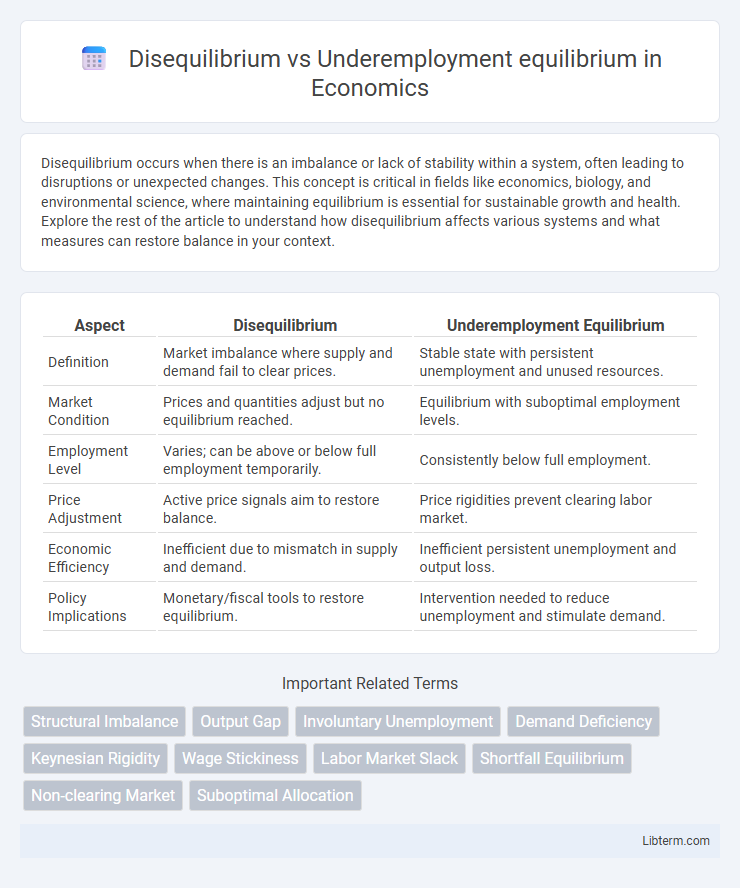Disequilibrium occurs when there is an imbalance or lack of stability within a system, often leading to disruptions or unexpected changes. This concept is critical in fields like economics, biology, and environmental science, where maintaining equilibrium is essential for sustainable growth and health. Explore the rest of the article to understand how disequilibrium affects various systems and what measures can restore balance in your context.
Table of Comparison
| Aspect | Disequilibrium | Underemployment Equilibrium |
|---|---|---|
| Definition | Market imbalance where supply and demand fail to clear prices. | Stable state with persistent unemployment and unused resources. |
| Market Condition | Prices and quantities adjust but no equilibrium reached. | Equilibrium with suboptimal employment levels. |
| Employment Level | Varies; can be above or below full employment temporarily. | Consistently below full employment. |
| Price Adjustment | Active price signals aim to restore balance. | Price rigidities prevent clearing labor market. |
| Economic Efficiency | Inefficient due to mismatch in supply and demand. | Inefficient persistent unemployment and output loss. |
| Policy Implications | Monetary/fiscal tools to restore equilibrium. | Intervention needed to reduce unemployment and stimulate demand. |
Understanding Economic Equilibria
Disequilibrium occurs when market supply and demand are not balanced, leading to excess supply or demand, whereas underemployment equilibrium refers to a state where resources, particularly labor, are not fully utilized despite apparent market stability. Understanding economic equilibria involves analyzing factors like wage rigidity, price stickiness, and market imperfections that prevent the economy from reaching full employment. Identifying these distinctions helps policymakers address unemployment and inefficiencies by targeting structural and cyclical imbalances in labor and product markets.
Defining Disequilibrium in Economics
Disequilibrium in economics occurs when market supply and demand are not balanced, leading to price distortions and inefficiencies. This state contrasts with underemployment equilibrium, where the labor market clears but at a suboptimal employment level without full utilization of resources. Disequilibrium often results from price rigidities, external shocks, or policy interventions that prevent markets from reaching a natural equilibrium.
What is Underemployment Equilibrium?
Underemployment equilibrium occurs when labor market conditions result in persistent unemployment or underutilization of workers despite wages adjusting to balance supply and demand. It reflects a state where job seekers accept part-time work or jobs below their skill level because full employment is unattainable at the current wage rate. This phenomenon highlights inefficiencies in labor markets caused by factors such as wage rigidity, skill mismatches, or insufficient aggregate demand.
Key Differences Between Disequilibrium and Underemployment Equilibrium
Disequilibrium occurs when labor supply and demand are mismatched, causing unemployment or unfilled jobs, while underemployment equilibrium involves workers employed below their skill or capacity level despite balanced labor market conditions. Disequilibrium reflects temporary disruptions caused by factors like wage rigidity or market imperfections, whereas underemployment equilibrium indicates structural issues such as skill mismatches or inefficient resource allocation. Key differences include the causes--market disequilibrium vs structural constraints--and the nature of unemployment--frictional or cyclical in disequilibrium versus chronic and structural in underemployment equilibrium.
Causes of Disequilibrium in Markets
Disequilibrium in markets arises from factors such as sudden shifts in demand or supply, price rigidities, and external shocks that prevent the market from reaching a stable equilibrium. Causes include mismatched wage expectations, government-imposed price floors or ceilings, and inefficient information flow between buyers and sellers. Unlike underemployment equilibrium, where labor markets settle at a suboptimal employment level due to wage rigidities and demand deficiencies, disequilibrium reflects transient imbalances disrupting normal market clearing.
Factors Leading to Underemployment Equilibrium
Underemployment equilibrium occurs when labor market imperfections such as wage rigidity, skill mismatches, and lack of adequate job information prevent full employment despite available labor supply. Factors leading to underemployment equilibrium include minimum wage laws that keep wages above market-clearing levels, structural shifts causing sectoral labor demand changes, and insufficiencies in worker training limiting adaptability. This results in persistent unemployment or underutilization of workers even when the economy produces output at less-than-optimal levels.
Impacts on Labor Market and Employment
Disequilibrium in the labor market occurs when supply and demand are mismatched, leading to unemployment or labor shortages, disrupting wage stability and job availability. Underemployment equilibrium signifies a persistent state where workers are employed below their skill level or for fewer hours than desired, causing inefficiencies and suppressed income growth. Both conditions hinder optimal labor allocation, reducing economic productivity and limiting overall employment quality and market flexibility.
Policy Responses to Disequilibrium and Underemployment
Policy responses to disequilibrium focus on restoring market balance through monetary tightening, fiscal adjustments, and exchange rate interventions to address external imbalances and inflationary pressures. In contrast, policies targeting underemployment equilibrium emphasize labor market reforms, skills training programs, and demand stimulation to increase job creation and improve workforce productivity. Both approaches require coordinated economic strategies to stabilize incomes and promote sustainable growth while mitigating structural inefficiencies.
Case Studies: Real-World Examples
Disequilibrium in labor markets occurs when job vacancies and unemployment rates mismatch, as seen in Japan's post-bubble economy where structural shifts created persistent skill gaps. Underemployment equilibrium is demonstrated by economies like India, where high labor force participation coincides with widespread underutilization of skills in informal sectors. Case studies reveal that targeted policy interventions, such as Germany's vocational training programs, effectively reduce disequilibrium by aligning worker skills with market demands.
Conclusion: Addressing Economic Imbalances
Addressing economic imbalances involves differentiating between disequilibrium and underemployment equilibrium, where disequilibrium reflects market disruptions causing temporary mismatches, and underemployment equilibrium indicates persistent underutilization of labor despite market stability. Effective policy measures must target structural reforms that enhance labor market flexibility and stimulate demand to reduce chronic unemployment and optimize resource allocation. Understanding these distinct economic states enables tailored interventions that promote sustainable growth and full employment.
Disequilibrium Infographic

 libterm.com
libterm.com